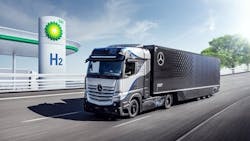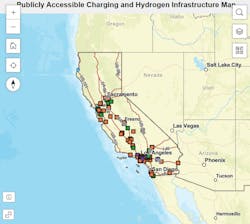California Energy Commissions Posts EV Charging and H2 Fueling Dashboard for Trucking Industry
The California Energy Commission (CEC) has released a new online dashboard mapping out more than 16,000 charging and hydrogen fueling points for medium and heavy (MDHD) zero emission vehicles across the state.
The dashboard not only tracks California’s progress of having sufficient charging ports and hydrogen fueling nozzles for MDHD zero emission vehicles (ZEVs) but also assists in future funding decisions on infrastructure deployment across the state.
Most of the charging points are located in private depots serving specific fleets, which deploy infrastructure to support their local and regional needs. These private depots are supplemented by an increased number of publicly available stations developed across the state and supported by grant funding programs.
“This new dashboard will be an invaluable tool in creating transparency, showing the ongoing progress in deploying infrastructure, and evaluating MDHD ZEV infrastructure needs across the state,” said Hannon Rasool, director of the CEC’s Fuels and Transportation Division, in a statement. “Transitioning California’s critical freight corridors to zero-emission is crucial to meeting California’s climate goals and making the air cleaner in vulnerable population centers.”
Among the new charging and hydrogen fueling points includes the Port of Long Beach, which launched the FM Harbor EV Charging Depot recently. Meanwhile, waste collection and recycling firm Recology announced it was testing a hydrogen fuel cell-electric vehicle developed by Hyzon and New Way Trucks. (EnergyTech Editor’s note: Hyzon recently filed for bankruptcy protection).
Publicly accessible MDHD ZEV charging and hydrogen fueling station data was obtained by the CEC through an interagency effort with the California Transportation Agency (CalSTA), California Transportation Commission (CTC), Caltrans, California Public Utilities Commission (CPUC), California Air Resources Board, and various air quality management districts across California.
The dashboard enables users to locate publicly accessible MDHD ZEV charging and hydrogen fueling stations being developed in California. Data fields include the address of public stations, port and/or nozzle counts, and additional information as available including charging and refueling specifications and eligible vehicle classes.
The CEC seeks additional public input on the dashboard, which is for developing ZEV infrastructure to help meet zero-emission transportation goals.
Trucks account for over 35% of California’s transportation emissions and a quarter of the state’s on-road greenhouse gases. Investments in MDHD ZEV stations and infrastructure will result in cleaner air and fewer cases of asthma near major transportation corridors.
According to the California Air Resources Board (CARB), the sales of new MDHD ZEVs doubled in 2023 as compared to 2022, representing one out of every six new vehicles sold for services including last-mile delivery, freight transportation, and school buses. Additionally, CARB and CEC announced a new statewide funding program to put 1,000 new, zero-emission school buses on the road.
The Innovative Clean Transit regulation requests all California transit agencies to submit data on their progress towards zero-emission bus (ZEB) fleet. As of 2023, according to CARB’s Innovative Clean Transit Reporting Tool, transit agencies reported having nearly 900 ZEBs in their fleets.

